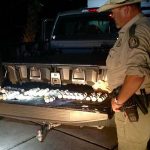To protect the elderly and disabled residents of Florida’s 683 nursing homes from the ravages of an Irma-like storm or other disaster, state law requires that administrators submit detailed emergency plans to regulators every year.
Will residents have enough food and water to survive a prolonged siege? Where will they go during a mandatory evacuation? How will they get there? Is there a generator to operate air-conditioning systems or respirators?
But if viewing the emergency management plan is on your checklist of things to do before moving a loved one into a South Florida nursing home, good luck. Two counties, Broward and Palm Beach, refused to release emergency plans when the Miami Herald filed public records requests, citing a state law designed to protect public spaces from terrorists. Miami-Dade released plans for its 54 nursing homes, but they were heavily redacted, leaving crucial information out of reach.
The disaster plans aren’t merely bureaucratic exercises. The Rehabilitation Center of Hollywood Hills provided an object lesson in the consequences of failure in September when Hurricane Irma left the nursing home without a functioning cooling system. Fourteen elders died.
What information is available points to a troubling reality: Many of the plans will be of little help the next time a hurricane rumbles through.
Police cordon off the Rehabilitation Center at Hollywood Hills, which had no air conditioning after Irma knocked out a transformer. The death toll, initially six, would climb to 14.
John McCall Sun Sentinel
“Who are these bureaucrats who are telling consumers what they can, and cannot, have from their grandmothers’ nursing homes? We are the taxpayers; we fund these places,” said Brian Lee, executive director of Families for Better Care, a long-term care residents’ advocacy group.
When Irma’s winds battered Florida’s east coast Sept. 10, it took the Rehabilitation Center at Hollywood Hills’ air-conditioning system with it. The home was directly across an alley from one of Broward’s largest public hospitals, Hollywood’s Memorial Regional. The home’s staff waited hours to act as the facility become a deadly sweat lodge. Police and regulators still are investigating the 14 deaths.
On Sept. 16, Gov. Rick Scott issued a series of emergency orders — the most controversial of which was to require nursing homes and assisted living facilities to have generators and adequate fuel to sustain operations and cooling systems for at least 96 hours after a disruption. Another requirement: All local emergency management agencies “must post all approved emergency management plans to their website within 10 days of the plan’s approval.”
Six residents died Wednesday morning, Sept. 13, 2017, after a transformer breakdown killed the air conditioning. The death toll would climb in subsequent hours and days to 14. The deaths remain under a criminal investigation.
Charles Trainor Jr. ctrainor@miamiherald.com
Hollywood Hills’ 43-page emergency management plan was supposed to prevent the kind of tragedy that left more than a dozen dead. But, amid the details on clean linen and canned food, the plan made no mention of how administrators would keep residents cool if power was lost. The plan included in-house self-evaluations with “excellent” grades and sections that were copied and pasted from a prior year.
Whether Hollywood Hills’ emergency plan represents the norm rather than an exception is hard to say. After the Miami Herald first wrote about it, underscoring its flaws, Broward County emergency managers suggested they had released it in error and declared it, and all others, confidential. Palm Beach County administrators initially agreed to release a handful of requested emergency plans, then changed their minds as well.
While Miami-Dade released its plans, county officials said the redacted information reflects sensitive security details — but declined to tell the Herald why information about food supplies, among other things, would represent a “security” threat.
Dolores Biamonte, 57, was photographed after she was evacuated from the Rehabilitation Center at Hollywood Hills. She later died.
Sean Greene
“What we have seen from consumers and federal investigators is a greater demand for transparency,” said Lee, of the advocacy group. “This is the exact opposite direction of what consumers are demanding, the shrouding of information that is crucial for people to know when they are placing a loved one in a nursing home. These are obvious questions you would ask a nursing home. What will happen in an emergency situation?” added Lee, former Florida long-term care ombudsman.
Despite the redactions, the 54 emergency plans reviewed by the Miami Herald provide potent clues as to what some lawmakers and county administrators want to keep under wraps — and paint a bleak picture of government oversight of one of the state’s most powerful industries.
One in four of the plans that were submitted by homes were largely blank. One in three of the plans acknowledged that the nursing home failed to maintain a week’s supply of emergency food rations, a state requirement. Twenty-nine of the homes failed to report how long it would take to evacuate all their residents in a disaster or emergency.
One of the homes, in Northeast Miami-Dade, answered most questions with “see plan.” The plan was not included in what the county released to the Herald.
Statewide, about 8,000 healthcare and social service providers are required to develop emergency plans as a condition of their licenses, representing 275,000 beds.
“The emergency rule requires that all approved plans be posted online by the county emergency management officials within 10 days of the plans approval,” said Mallory McManus, spokeswoman for the state Agency for Health Care Administration, which licenses and oversees nursing homes and assisted living facilities. “AHCA has begun the permanent rule-making process and is working with the legislature to ensure increased transparency for emergency plans.”
A resident is wheeled out of the Rehabilitation Center at Hollywood Hills after a transformer malfunction caused by Irma knocked out the air conditioning. Ultimately 14 people died. Memorial Regional Hospital was right next door.
Amy Beth Bennett AP
At a Nov. 9 hearing of the Florida House of Representatives’ Select Committee on Hurricane Response and Preparedness, AHCA Deputy Secretary Molly McKinstry said oversight of emergency plans falls to county offices of emergency management.
“In reality,” McKinstry said, “we do not see a lot of plans during the review process. We are available if there are questions. But I think there are significant challenges to trying to review plans and then turn around with a decision within 60 days.”
The plans “underscore the importance of these facilities being self-sufficient during an emergency,” McKinstry said. They really are designed to require facilities to think through all situations they may encounter. If they need to evacuate. What type of floor zone or evacuation zone are they in? How will they get there? How will they return?
If self-sufficiency is the goal, it’s hard to view events from week of Sept. 10 as anything but discouraging.
In the days before Irma struck, Gov. Scott offered his personal cellphone number during a conference call with long-term care operators who were becoming increasingly anxious as the behemoth formed in the Atlantic. Dozens of calls were made. Many of the inquiries were routed to Justin Senior, AHCA’s secretary.
Days after the storm, the Scott administration released to reporters more than 100 pages of records detailing its response both to the disaster at Hollywood Hills and to the aftermath of Irma in general. The records included 12 pages of Senior’s handwritten notes, a veritable laundry list of emergency planning lapses.
All of those government-approved emergency management plans notwithstanding, scores of nursing home didn’t have — and couldn’t get — shutters or plywood to board up their windows, generators or other emergency power, and access to grocery shipments, some of which couldn’t traverse tree-strewn roadways. Some couldn’t find beds for residents with special needs. Others had beds but no way to get to them.
“All caregivers quit and/or evacuated,” the owner of one Hillsborough County assisted living facility told the state.
“Trying to find plywood, batteries, generator,” the operator of a Bradenton center said.
“Just needs transportation and shelter,” one Scott aide wrote of the operator of a Broward County center with 300 residents. “Sounds like he can provide staff and food.”
Of an adult living facility in Naples, an aide to Scott wrote: “Took on evacuees and is now over capacity and only has 12 hours of fuel on generator.”
The operator of a Fort Myers ALF that caters to elders with dementia told authorities he had signed agreements with other locations for the evacuation of his residents, “but those facilities evacuated already.” Likewise, a Bradenton ALF complained that it had an evacuation agreement with a local nursing home, but that “now, [they are] not honoring it.” Senior wrote of a Cape Coral center: “Told to evacuate — no place to go.”
Elie Pina of Hollywood, whose mother was a resident at the Rehabilitation Center of Hollywood Hills, arrived at the nursing home amid reports that residents were being overcome by heat after Irma knocked out the air conditioning. Ultimately 14 people died.
John McCall Sun Sentinel
The failure of reciprocal evacuation plans was palpable after Irma. In some cases, homes couldn’t evacuate to the place they’d planned because that home, often in the same neighborhood or city, had no power either.
If consumers are worried about that possibility, though, there’s no way to tell where their elderly parents or grandparents will be evacuated to. In the Miami-Dade plans — the only ones the Herald could obtain at all — that information is blacked out.
Charles Cyrille, division director of emergency management for Miami-Dade, said two people within the office review the plans for nursing homes and assisted living facilities throughout the year. Each year, nursing homes must resubmit updated agreements concerning access to water, transportation, food and sheltering arrangements in case of disaster.
The portion of the plan detailing staff responsibilities and organization in an emergency, as well as family notification, is supposed to be kept up to date, he said.
He said he’ll be looking into why some of this information would be missing.
“It’s supposed to be kept up to date,” Cyrille said. “I will definitely look into that.”










